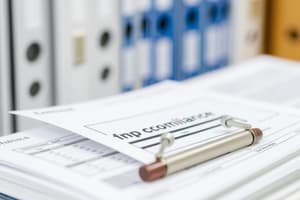Podcast
Questions and Answers
What is the main reason for digitizing records in recent years?
What is the main reason for digitizing records in recent years?
Digitization of records in recent years is primarily for safekeeping.
Describe two characteristics of records in the 'current' or 'active' stage.
Describe two characteristics of records in the 'current' or 'active' stage.
Records in the 'current' or 'active' stage are frequently used and have a high accumulation rate because they are needed often.
What are two potential uses of records in the 'dominant' or 'inactive' stage?
What are two potential uses of records in the 'dominant' or 'inactive' stage?
Inactive records can be useful for research, historical studies, legal matters, or fiscal purposes.
Why is it important to have a secure storage system for active records?
Why is it important to have a secure storage system for active records?
Why might it be beneficial to outsource your records management?
Why might it be beneficial to outsource your records management?
What does the term "appraisal" mean in the context of record keeping?
What does the term "appraisal" mean in the context of record keeping?
Define "electronic record" as described in the text.
Define "electronic record" as described in the text.
What types of records are included in "administrative records"?
What types of records are included in "administrative records"?
What is the difference between "current records" and "non-current records"?
What is the difference between "current records" and "non-current records"?
Describe the role of the "authorized officer" in record keeping, according to the provided text.
Describe the role of the "authorized officer" in record keeping, according to the provided text.
Flashcards
Record Keeper
Record Keeper
The individual responsible for maintaining records in the record room under administration.
Administrative Records
Administrative Records
Documents related to support functions like HR, finance, and property management.
Appraisal
Appraisal
The process of determining the value of a record for disposal purposes.
Current Records
Current Records
Signup and view all the flashcards
Non-Current Records
Non-Current Records
Signup and view all the flashcards
Destruction Policy
Destruction Policy
Signup and view all the flashcards
Semi-Current Records
Semi-Current Records
Signup and view all the flashcards
Dominant Records
Dominant Records
Signup and view all the flashcards
Outsource Records Management
Outsource Records Management
Signup and view all the flashcards
Study Notes
Records and Information Management
- This unit covers record and information management competencies.
- Competencies include establishing regulatory and social environments, determining principal areas of risk requiring recordkeeping strategies, determining record requirements for each business function and establishing a recordkeeping framework for the organization.
Performance Standards
- Identify and document legal and regulatory frameworks for the organisation, in accordance with industry standards.
- Analyse and document legislation for its implications for recordkeeping, as per the organisation's policy.
- Review documentation of organisational functions for compliance.
- Review and document regulatory requirements and legal liabilities, considering their impact on recordkeeping frameworks.
- Determine and document risks and liabilities to be managed by recordkeeping.
- Determine and analyse risks, liabilities, and regulatory requirements against each business function.
- Develop and communicate an overview of recordkeeping responsibilities within the organisation.
- Define responsibilities and authorities in relation to regulatory requirements, according to industry standards.
- Identify and integrate risks and liabilities managed by recordkeeping, with the definition of responsibilities for each function.
- Define, assign, and document levels of accountability and responsibility for each level of recordkeeping, as per organisational policy.
Learning Outcomes
- Establish regulatory and social environments.
- Determine principal areas of risk requiring recordkeeping strategies.
- Determine record requirements for each business function.
- Establish recordkeeping frameworks for the organisation.
Studying That Suits You
Use AI to generate personalized quizzes and flashcards to suit your learning preferences.




